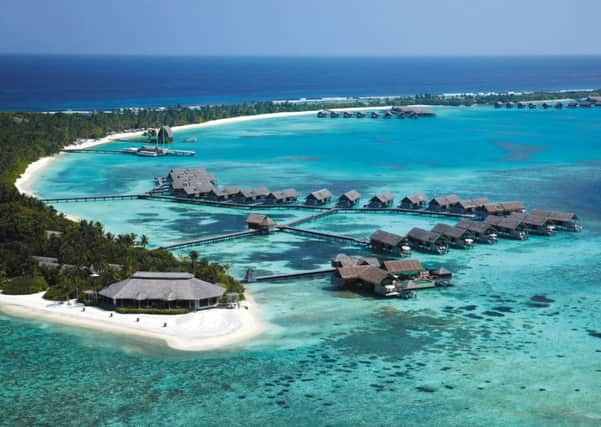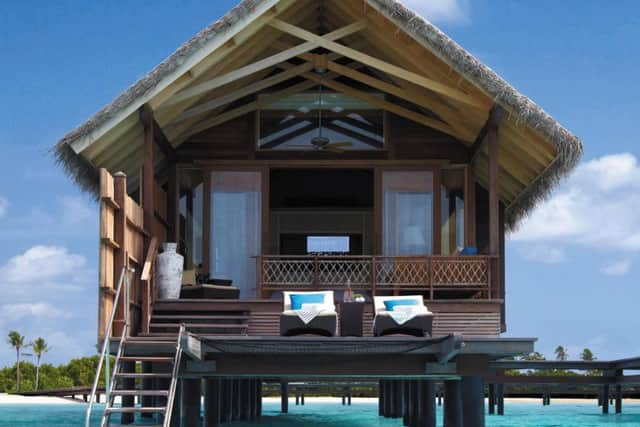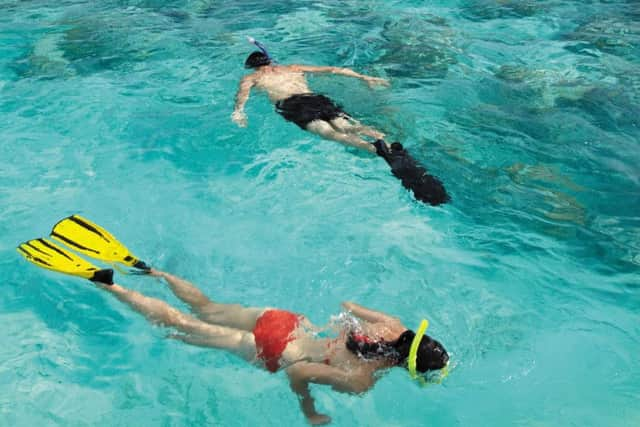Travel: Maldives, the island of paradise


Despite having lived in Scotland for almost ten years, I am teeing off with the first golf shot of my life. It is a sweltering 35C, and the pressure is doing nothing to dry my sweaty palms. The pin is just 80 yards away, but don’t underestimate the challenge before me: if I drift too far to the left, a sand trap in the shape of a sea turtle waits to gobble up my ball; to the right, the small matter of a water hazard – the roaring surf of the Indian Ocean, with nothing between the first hole at the Shangri La’s Villingili Resort & Spa and Antarctica, 10,000km away.
My anxiety suddenly multiplies: what if I knock it into the coral reef that surrounds this tiny island? My volunteer golf coach Manaf, a Malaysian former pro squash player who is the resort’s recreation manager, reassures me. Taking out a slightly pink golf ball, he gives it a gentle shake, emitting a dim rattle. “It’s completely biodegradable,” he says. “Within 48 hours of hitting the water, it dissolves.”
Advertisement
Hide AdThe nine-hole course, squeezed into the point of Villingili on the southernmost Addu Atoll of the Maldives, and its fish-food golf balls are both typical of the ingenuity that sees immersive luxury delivered flawlessly on little more than a spit of sand in the middle of the Indian Ocean. Deeper within the golf course is another example: Mount Villingili, the highest point in the Maldives. As a sign post cheerily tells you, the raised tee stands all of 5.1 metres above sea level.


The threat of global warming means that, by some estimates, the entire archipelago could begin to vanish beneath the waves in as little as 30 years. Plans are already being drawn up by the Maldivian government to buy land on the Indian subcontinent for a mass exodus of the country’s 340,000 people.
Time is running out to see this paradise at the vanishing edge of the world. And getting to Villingili certainly feels like an epic voyage. Flying in on a commercial airline means changing at the capital, Male, on to a twin-engine turboprop operated by Maldivian Airlines for a flight south that takes 70 minutes. We’re met by Shangri La staff at Gan, and whisked by power boat across the atoll to Villingili, where we’re offered fresh coconut water straight from the fruit and the first of the many lavender-scented cold towels that greet you at most places in the resort.
The island is picture-postcard beautiful with pristine white sand beaches bordered by the shallow turquoise waters of the reef. Push into its modest “interior” and you’re surrounded by tropical jungle, with “flying fox” bats the size of gulls swooping through the canopy, nabbing fruit from the trees.
I stayed in a water villa, which sits on stilts at the edge of the reef and is connected to the beach and neighbouring villas by a wooden causeway. There are other, more private rooms available on land: villas with their own pool, and those that offer private access to the beach, as well as tree house villas that are the most secluded and have the best views of the sea. All have the same luxurious interior, and an enclosed outdoor shower, for low-risk exhibitionism.


The Maldives has catered primarily to two groups since its tourism industry began in earnest, just a few decades ago: the wealthy of Europe, the Middle East and latterly China, and honeymooners. Now resorts like the Shangri La Villingili want to tempt couples and families looking for a more active, culturally stimulating experience. Every kind of water sport is catered for, from kayaking and paddle boarding to dolphin cruises, snorkelling and scuba diving around the Second World War wreck of the MV British Loyalty. The resort also runs excursions to local villages and the former RAF base at Gan, where 1960s British military architecture and carefully laid out streets are crumbling in a charmingly post-colonial fashion.
Advertisement
Hide AdThree excellent restaurants cater to every taste from Europe to East Asia, but there are options for outdoor dining, too – the resort lets you “Dine by Design” at secluded spots around the island, from barbecues on the beach to stargazing dinners at the “summit” of Mount Villingili. My favourite meal, however, was a picnic lunch in the pavilion in the resort’s hidden kitchen garden, where executive chef Filippo Abisso showed us row upon row of herbs, vegetables and chillies. It looked like something you’d find behind a rustic Tuscan villa rather than in a jungle clearing, but the garden isn’t ornamental – Chef Abisso tests out crops before hiring local farmers to grow them for him, providing sustainable employment and reducing shipping. Fifteen per cent of all produce used in the kitchen, from the sweet little Addu bananas left in your room to the fish eaten at breakfast, lunch and dinner is sourced from local farmers and fishermen.
If you want, you can even catch your own dinner. One morning I’m up before the sun to join the resort’s big game fishing team. Maldivian army veteran Mohammed and the rest of the crew set the lines with specialist lures for different types of fish, and we set off up the outside of the atoll. It’s a waiting game – with freshly brewed coffee and viennoiseries – but when the line starts rattling, you’re in the hot seat, reeling in the catch. I manage to haul aboard a wahu, which resembles a large barracuda, about a metre long, but the real prize, a yellowfin tuna, manages to escape the line just in time. A member of the kitchen staff takes your order as you step back on to the dock. Wahu makes exceptional sashimi.
Advertisement
Hide AdThe best time to go to the Maldives is during its dry season, from around December to March. We went in June, which meant partial cloud and a few showers. The Shangri La’s signature Chi spa is the place to be if the weather closes in. After a relaxing light yoga session, I opt for the Kandu Boli, a Maldivian massage using giant cowry shells and hot coconut oil, heated in the shells over a candle. The treatment begins with the shells being held over your ears as the masseuse sings a Maldivian lullaby. The sound of the sea in your ears mixes with the waves, visible a stone’s throw away through the glass doors. It ends, after every limb and muscle has been basted and pummelled with the warmed shells, with a deep scalp massage. I didn’t do spas before. There’s no zealot like a convert.
With everything there is to do and see, somehow I leave snorkelling the house reef until my final afternoon. Mountains of coral sprout in all shapes, sizes and colours, in turns craggy or bulbous, their sides grazed by schools of fish even more colourful than the reef. In the ravines, there are giant clams the size of handbags, with velvety insides that squeeze shut as you pass. In the distance, a sea turtle, huge by comparison with the other reef life around it, looms slowly into the edge of my field of vision, like the hull of a battleship. It hovers there before receding into the dark. Like many in the Maldives, a fragile, once-in-a-lifetime experience.
• Oman Air (08444 822309, www.omanair.com) is the only airline to fly daily, non-stop and direct to Muscat, Oman from London. Return flights to the Maldives via Muscat are available from £587pp, including taxes, subject to availability. The Pure Maldives package starts from £600 per night including domestic round-trip flights from Male to Gan for two people on MaldivianAirlines,breakfast Dine by Design, one Big Game Fishing Excursion, complimentary green fees to the resort’s golf course and complimentary water sports, www.shangri-la.com/Maldives